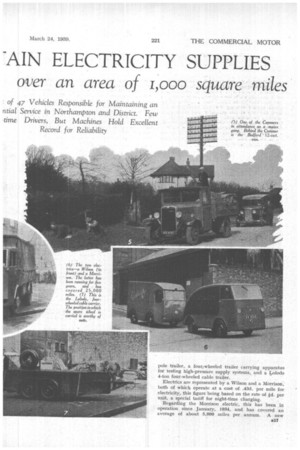HOW ROAD MOTORS MAP 'AIN ELECTRICITY SUPPLIES
Page 42

Page 43

Page 44

If you've noticed an error in this article please click here to report it so we can fix it.
over an area of i,000 square miles
of 47 Vehicles Responsible for Maintaining an atial Service in Northampton and District. Few time Drivers, But Machines Hold Excellent Record for Reliability AS will readily be realized, it is no mean task effectively to service an extensive area with such a vital commodity as electricity: One of the main essentials, of course, is a large fleet of roadtransport vehicles, for the efficiency of the service given is largely dependent upon the transport department.
In the case of, the. Northampton Electric Light and Power Co., Ltd., and its subsidiary companies, the head offices of which are in Ftridge Street, ,Noethampton, an area of approximately i,000 squale miles comes under its direct control and for this purpcse, a fleet of 47 vehicles is employed..
The major_ portion of. the work involved being of .a light character, the types of machine used are in conformity, and, therefore, we find no fewer. than 24 Austins—Twelve-Four and Ten-Four vans and Big Seven and Ten saloons—figuring on the list. The latest Austin acquisition is a Twelve-Four, the body of which has been designed for carrying a multitudinous range of spare parts for domestic electrical apparatus. It is actually designated a repair van and has, more or less, a roving commission.
A comparatively recent addition is a Bedford 12-cwt. van, which was acquired with a view to conversion to an ambulance, should the necessity arise. Incidentally, this vehicle, which is one of a few handled by a full-time l6 driver, records a petrol consumption equal to 27 m.p.g. It covers, on an average, 1,500 miles a month on waterheater service.
The company operates a smart Dennis 30 m.p.h. forward-control machine in connection with its overhead-mains construction work. It is equipped with a drop-sided platform body with tilt.
Heavier machines are found in the Commers, of which there are five—three NI models, a G2 and a Centaur. These, again, have platform bodies and, as occasion demands, are used as the tractive units for a
pole trailer, a four-wheeled trailer carrying apparatus for testing high-pressure supply systems, and a Lolode 4-ton four-wheeled cable trailer.
Electrics are represented by a Wilson and a Morrison, both of which operate at a cost of, .43d. per mile for electricity, this figure being based on the rate of id. per unit, a special tariff for night-time charging. Regarding the Morrison electric, this has been in operation since January, 1034, and has covered an average of about 5,000 miles per annum. A new 517 Fuller battery has just been installed after a total of 25,000 miles' running.
In view of the nature of the work involved, the company employs only six full-time drivers, so it is rarely that a machine is driven by the same driver on two consecutive days. In the majority of cases members of the engineering maintenance staff handle the vehicles and, having reached their destination, the machines are left standing, whilst the engineers• apply themselves to the particular job on hand. Such a system usually militates against securing the best results, but the general efficiency of this particular fleet rather tends to disprove this contention.
Over a period of five years, bearing trouble necessitating a tow-in has been experienced but once; the fleet has always been lubricated with oil supplied by the Vacuum Oil Co., Ltd. While on the subject of lubrica
tion, it is interesting to mention that, since a Streamline oil filter was installed some time ago, oil costs have been reduced by one-third.
We learnt from Mr. A. P. Crooke, transport manager, that, previous to the installation of the filter, sump drainage was carried out after every 5,000 miles' running, but now this is done after every 1,000 miles.
Mention has been made of the petrol consumption of the Bedford 12-cwt. van, and whilst this is 27 m.p.g., and on one of the Austin Big Sevens is nearly 50 m.p.g., the average, per month, for the whole fleet is 21 m.p.g.
The whole of the fleet is maintained by six men—a foreman, two mechanics and three mates, all repairs and overhauls being executed in the company's own works, as well as painting and the building and renovation of bodies. The transport department of this undertaking is, therefore, self-contained.




















































































